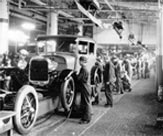Industry Restructuring
We continue to support the actions the federal government took to restructure the U.S. auto industry, make it more competitive and sustain a partnership with automakers. The restructuring was necessary, it was executed well, and it helped our U.S.-based competitors as well as companies all along our supply chain at a crucial time.
IN THIS SECTION
It’s a simple truth. Nations with strong, healthy economies still manufacture products people want and need. But it’s also true that manufacturing must evolve if it is to remain competitive and relevant in 2011 and beyond. The Importance of Manufacturing to the U.S. Economy can’t be underestimated. Though declining, manufacturing’s share of the U.S. GDP still stands at a critical 11 percent.
At Ford, we developed our own plan to change and restructure our business years before the economic downturn. It was the right plan, implemented at the right time, and that sense of urgency set Ford apart from the start — and enhanced our Competitiveness across the company and around the world.
One of our first tasks was restructuring Ford’s healthcare obligations. For retired hourly employees, we restructured our commitment to their long-term and ongoing healthcare needs by contributing $7.1 billion to the VEBA Trust, now administered by the UAW. To date, Ford has even exceeded our obligation to the trust by $500 million. With the VEBA in place, Ford won’t have to add the rising cost of retiree health care to the cost of our vehicles in the U.S., which will help us remain competitive here at home.
- This year, Americans will buy approximately 12 million cars and trucks.
- Each new car contains between 8,000 and 12,000 parts, and approximately 686,000 Americans work at the companies that produce those parts.
- The U.S. auto industry ranks third overall in R&D spend, ahead of software, aerospace and electronics manufacturers.
- Manufacturing’s share of the U.S. GDP is falling, but it still stands at an impressive 11 %
- If manufacturing levels continue to decline at present levels, they will slip below 10 percent by 2013.
- Last year, automakers spent approximately $148 billion on U.S. parts, helping keep vibrant a supply chain that employs 569,000 U.S. employees.
- Domestic automakers use more than twice as much U.S. content than the average non-U.S. competitor.
- Since 1999, Ford has reduced workplace injuries more than 90 percent.
Ford’s evolution is also happening on the line, where we continue to maintain a disciplined approach to Capacity Utilization, in order to keep our plants running efficiently and our product strategy nimble. Flexible Manufacturing is a guiding principle for our production process. It allows several different vehicles to be built on the same assembly line, so plants produce at maximum capacity, and Ford can respond quickly if customer preferences change. We have made great strides in effectively utilizing our production capacity in recent years, but we need to continue this progress to ensure that staffing levels match production needs and compete with the capacity utilization rates of our key global competitors.
There are other tests we’ll face in the years ahead to Ford’s continued growth. Navigating the Current Economic Landscape will continue to be challenging in the months ahead. It is also our view that Gas Prices will gradually rise over time and remain volatile, and that poses a significant challenge to all automakers. At Ford, we’ve built our business strategy around meeting this challenge. It’s why we’ve developed a balanced portfolio of vehicles to suit buyer tastes and fuel consumption budgets. It’s also why we’ve become a leader in hybrid and electric vehicle technologies.
Ford’s debt load is another challenge we’ll need to address if the company is to remain competitive. Ford has been making progress in the last few quarters by paying down our debt. We reduced $14.5 billion in 2010 alone, including the VEBA debt. In fact, our credit rating has steadily been upgraded over the last five quarters — which ultimately will lower our financing costs so we can more readily invest in new technologies and new products. But several key competitors continue to maintain stronger balance sheets than Ford, with much smaller debt loads.













